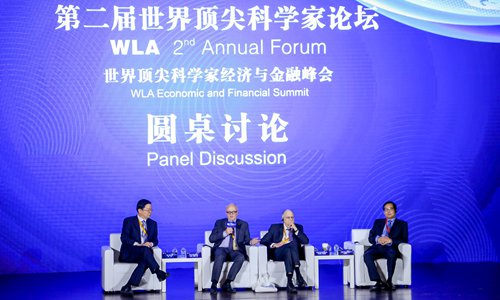HOME >> BUSINESS,METRO BEIJING
Metropolitan development drives industrial innovation
Source:Global Times Published: 2019/10/31 16:13:40

Gu Qiang (first from left), senior vice president of CFLD and head of the company's Industry Research Institute, joins in the panel discussion during the forum. Photo: Courtesy of CFLD
"Throughout the global development, we find that the distribution of innovation factors and the output of innovation achievements are constantly converging in geographical space. The world is becoming sharper," Gu Qiang, senior vice president of China Fortune Land Development (CFLD) and head of the company's Industry Research Institute, said in his speech during the 2nd Annual Forum of the World Laureates Association (WLA).The 2nd Annual Forum of the WLA kicked off in Shanghai on Tuesday and will continue until Friday. Besides delivering a speech on the topic "Metropolitan region: the 'innovation peak' facets, mechanisms, and practices," Gu also took part in the roundtable discussion flanked by world-leading experts in the field, including the Nobel Prize winners in economics Finn E Kydland and Thomas J Sargent.
The summit focused on the global trend of scientific, technological and financial development, innovation and entrepreneurship, global macroeconomic trend, and exploring the integration of technological and industrial frontiers.
Gu attempted to draw a comparison between the key metropolitan areas of China, the US, and Japan from the perspectives of population, GDP and innovative achievements. Through this comparison, he also analyzed the development process and trend of the main metropolitan areas at home and abroad from the perspectives of regional distribution of top talents, innovative achievements, and site selection of leading enterprises.
The results showed that the trend of transformation from the central city to the peripheral area is becoming more and more obvious. Taking the Beijing metropolitan area as an example, the average proportion of medical device technology spillover transfer increased from 27 percent in 2011-14 to 41 percent in 2015-18, and the importance of the peripheral circle was further highlighted.
The spatial model of "innovation peak + industrial highland" has become an important factor in regional competitiveness. As of now, 67 of the 165 enterprises that have applied for the scientific and technological innovation board are located in the Yangtze River Delta, accounting for 40.6 percent. Gu said only by following the law of innovation generation and innovation space evolution, actively building innovation ecology, and promoting the interactive development of innovation peak and industrial highland can the metropolitan area form a continuously improving innovative ability and regional competitiveness.
Established in 2013, the CFLD Industry Research Instituteaims for gathering elites from various industries, focusing on political and economic trends, regional development, cutting-edge technology and high-tech industries, and striving to build the world's top industrial research think tank. The institute's 12 postdoctoral fellows also participated in this world's top scientist s' forum.
Posted in: INDUSTRIES,ENTERPRISE